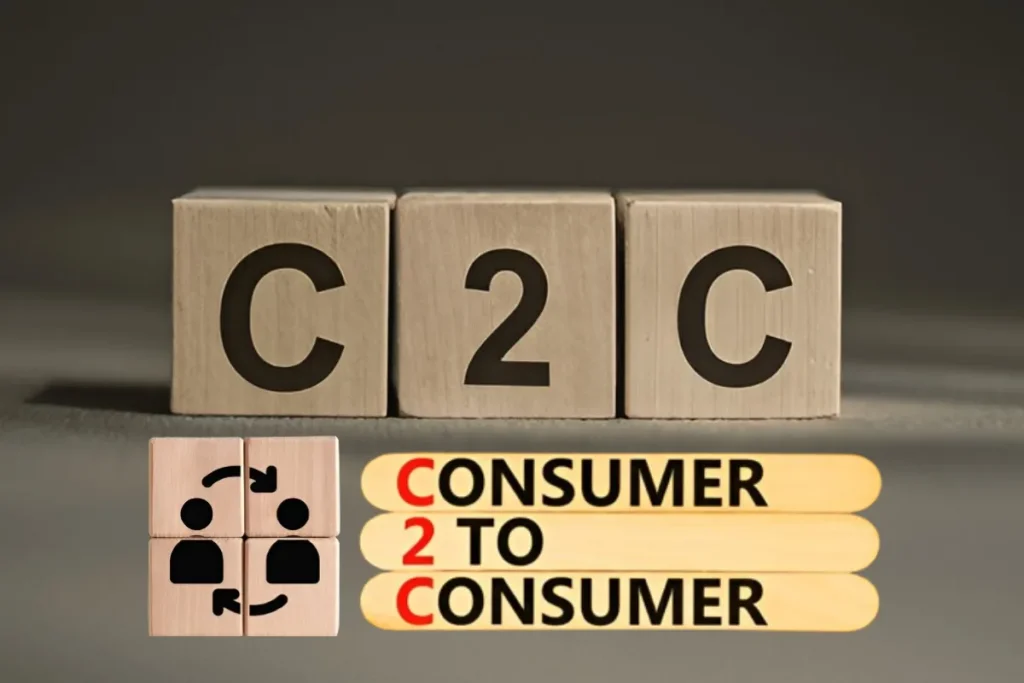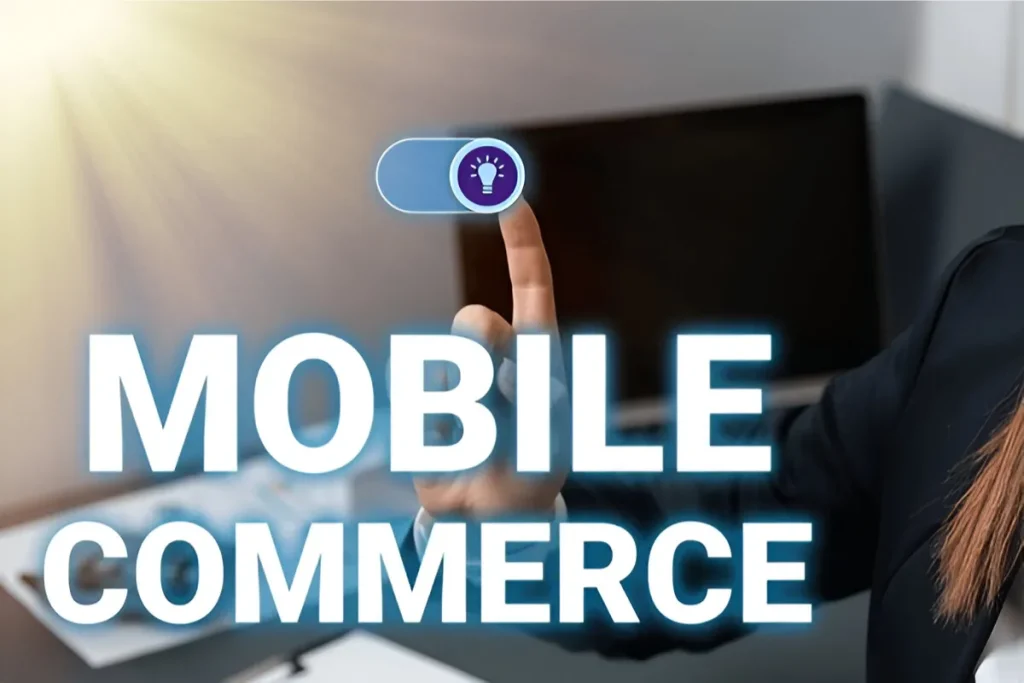C2C eCommerce | Innovative Solutions for Consumer-to-Consumer
Understanding the different models in eCommerce can be overwhelming. Many find themselves puzzled by terms like C2C or C-to-C, struggling to grasp their true meaning.
This guide is here to clarify the meaning of Consumer-to-consumer. We will break down the concept of consumer-to-consumer commerce, offering clear explanations and practical examples.
What Is C2C eCommerce?

Consumer-to-consumer eCommerce refers to the online exchange of goods and services between consumers. Unlike traditional business models, it allows individuals to sell products directly to other consumers.
This is often through platforms like eBay or Craigslist. This model is gaining popularity due to its simplicity and direct interaction between buyers and sellers.
How It Works
Consumer-to-consumer eCommerce operates through online marketplaces. These platforms provide a secure environment for transactions between individuals. Consumers can list items for sale and communicate with potential buyers.
Payments are processed securely. The usual steps include listing an item, negotiating terms, and completing the sale through a secure payment gateway.
Types of Consumer-to-consumer Businesses
Online Classified Ads
Online classified ads are an example of an e-commerce business. Platforms like Craigslist and OLX allow users to buy and sell items directly.
These ads cover various categories, such as electronics, real estate, and job listings. Users can post listings easily, making it convenient for individuals to connect.
P2P Marketplaces
Peer-to-peer (P2P) marketplaces facilitate transactions between individuals. Sites like eBay and Facebook Marketplace are well-known examples.
They offer secure platforms for consumers to trade goods. Users can sell items at fixed prices. This provides transaction flexibility.
Real Estate Platforms
Consumer-to-consumer real estate platforms connect buyers and sellers without intermediaries or management. Websites like Zillow and Redfin help users find properties.
These platforms provide valuable information and tools for property transactions, such as price comparisons and neighborhood details. This approach makes buying and selling a property more accessible and transparent.
Interested in how businesses interact directly with consumers? Explore the differences and similarities in our insightful piece on B2C Commerce.
Examples of Consumer-to-consumer Commerce
Popular Consumer-to-consumer Platforms
Several platforms exemplify the Consumer-to-consumer eCommerce model. eBay business model is one of the most well-known, allowing users to auction or sell items at fixed prices.
Craigslist is another popular platform where individuals can post ads for a variety of goods and services.
Niche Marketplaces
Beyond mainstream platforms, there are niche Consumer-to-consumer marketplaces catering to specific needs. For example, Etsy focuses on handmade or vintage items, providing a marketplace for artisans and crafters.
Poshmark is another niche platform where users can buy and sell fashion items. These specialized marketplaces make it easier for consumers to find exactly what they need.
The Advantages of Consumer-to-Consumer for Marketplace Owners
Cost-Effective Operations
One of the main advantages of Consumer-to-consumer eCommerce for marketplace owners is its cost-effectiveness. And it’s one place collaboration between Consumer and Clients.
Consumer-to-consumer platforms typically require less investment in inventory and logistics since the transactions are between individual consumers. This reduces operational costs significantly.
Direct Consumer Interaction
Consumer-to-consumer platforms allow for direct interaction between buyers and sellers. This direct communication adds to customer satisfaction.
Issues can be resolved quickly without intermediaries. It also fosters a sense of community and trust among users.
Lower Marketing Expenses
Marketing costs are generally lower for Consumer-to-consumer platforms. Since the platform becomes a hub for buyers and sellers, word-of-mouth and user-generated content drive traffic. This organic growth reduces the need for expensive advertising campaigns.
Pros and Cons of Consumer-to-Consumer for Buyers and Sellers
Benefits for Buyers
Consumer-to-consumer eCommerce offers several benefits for buyers. They can find unique or rare items that aren’t available in traditional stores.
Buyers often enjoy lower prices due to the absence of intermediaries. Additionally, they can negotiate directly with sellers for better deals.
Benefits for Sellers
Sellers also gain from the Consumer-to-consumer model. They can reach a broad audience without needing a physical store. This model allows for quick and easy transactions. Sellers can also set their prices and conditions for their products.
Challenges and Risks
Despite the benefits, there are challenges in Consumer-to-consumer eCommerce. Trust issues can arise as transactions are between individuals.
There may be risks of fraud or scams. Both buyers and sellers need to be cautious and use secure payment methods.
Finding the Right Consumer-to-consumer Platform
Look for several key features when choosing a Consumer-to-consumer platform. The platform should have a user-friendly interface.
Secure payment options are crucial to protect transactions. It’s also important to have customer support available in case of any issues. Here are the tips to help you choose the best platform:
- Consider the type of items you want to buy or sell.
- Some platforms specialize in certain categories, such as fashion or electronics.
- Research user reviews to get an idea of the platform’s reputation.
- Ensure the platform offers necessary tools for listing and selling items efficiently.
- Check for user-friendly navigation and design.
- Verify the platform’s security measures for transactions.
- Look for platforms with reliable customer support.
Just as businesses often rely on staff augmentation to enhance their workforce for specific tasks, choosing the right channel marketing partners can bring specialized expertise to optimize your marketing efforts.
Building a Robust Consumer-to-consumer Business Model
A successful Consumer-to-consumer business model requires several key components. First, the platform must be user-friendly and easy to navigate. It should also offer secure payment options to protect users’ transactions.
Moreover, effective customer support is essential to handle any issues that may arise. Here are some strategies to build a strong Consumer-to-consumer business:
- Focus on user experience and make the platform intuitive.
- Implement robust security measures to ensure safe transactions.
- Offer excellent customer service to resolve issues quickly.
- Use marketing strategies to attract and retain users.
- Encourage user feedback to continuously improve the platform.
Effective PMB (Project Management Best practices) play a key role in managing channel marketing campaigns, ensuring that tasks are completed on time and objectives are met, which is crucial for long-term success.
Integrated Consumer-to-consumer Payment Processing
In Consumer-to-consumer eCommerce, secure payment processing is crucial. It protects both buyers and sellers from potential fraud and ensures trust in the platform.
A reliable payment system enhances user experience and confidence in the transactions. Here are some examples of secure payment solutions for Consumer-to-consumer platforms:
- PayPal: Widely used and trusted, it offers secure transactions and buyer protection.
- Stripe: Known for its robust security measures and easy integration with various platforms.
- Square: Provides secure payment processing along with tools for managing sales and inventory.
- Apple Pay: Provides a secure and convenient payment method for users with Apple devices.
- Google Pay: Allows users to make secure payments through their Google accounts.
- Cash App: Facilitates secure peer-to-peer payments with an easy-to-use interface.
Understanding the financial landscape is vital for secure transactions. Knowing what you will be left with after paying Capital Gains Taxes provides valuable insights
Capturing Niche Markets with Consumer-to-Consumer
Finding niche markets is crucial for the success of a Consumer-to-consumer platform. These niches can be based on specific interests, hobbies, or unique product categories.
For instance, platforms like Etsy cater to handmade and vintage items, while Poshmark focuses on fashion.
By identifying niche opportunities, you can attract a dedicated user base. Here are some strategies to target niche markets effectively:
- Research and understand the specific needs of your niche audience.
- Create specialized C and C marketing campaigns that resonate with your target users.
- Develop features and functionalities tailored to the niche market.
- Engage with your community through forums, social media, and events.
- Collect feedback from users to continuously improve the platform.
- Offer exclusive deals and promotions to attract niche market users.
- Collaborate with influencers and bloggers who have a following in the niche.
- Create content that educates and engages your target audience.
- Focus on building a loyal community through customer service marketing.
Consumer-to-Consumer Marketing
Consumer-to-consumer Marketing is a strategy that leverages consumer interactions and word-of-mouth to promote products and services.
Unlike traditional marketing, Consumer-to-consumer marketing relies on consumers to share their experiences and influence others.
Consumer-to-consumer Marketing is effective because it builds trust and authenticity. People tend to trust recommendations from friends, family, and other consumers more than traditional advertisements.
This form of marketing can lead to higher engagement and conversion rates, as it taps into genuine user experiences.
Effective marketing is key to a successful Consumer-to-consumer business. Learn how to optimize your marketing efforts by checking out channel-based strategies.
How to Get Started with Consumer-to-consumer Marketing
To begin with, Consumer-to-consumer Marketing focuses on creating a positive customer experience. Encourage satisfied customers to share their reviews and testimonials.
Utilize social media platforms to facilitate these interactions and provide incentives for referrals. Building a community around your brand can also enhance Consumer-to-consumer marketing efforts.
Influencer Marketing vs. Consumer-to-Consumer Marketing
Influencer marketing involves working with individuals who have many followers. Consumer-to-consumer marketing relies on everyday consumers.
Influencers reach a broader audience. Consumer-to-consumer marketing is more authentic due to personal connections.
Both strategies are effective. Consumer-to-consumer marketing often needs less investment and is more sustainable.
|
Aspect |
Influencer Marketing |
C2C Marketing |
|
Primary Participants |
Individuals with large followings |
Everyday consumers |
|
Reach |
Broad audience |
Personal connections |
|
Authenticity |
Varies, can be seen as promotional |
Highly authentic due to personal interactions |
|
Investment |
Often requires significant investment |
Generally requires less investment |
|
Sustainability |
Can be effective for campaigns |
More sustainable over the long term |
|
Effectiveness |
Effective for brand awareness and reach |
Effective for trust and engagement |
Revenue and Growth Strategies
Revenue Streams for Consumer-to-consumer Businesses
Consumer-to-consumer businesses have several revenue streams. Here are some key ones:
- Transaction Fees: Platforms charge a fee for each transaction completed on the platform.
- Advertising: Businesses can sell advertising space to other eCommerce companies.
- Subscription Fees: Users can pay for premium memberships for added features and benefits.
- Listing Fees: Platforms may charge users to list their products or services.
- Value-Added Services: Offering additional services like payment protection or delivery options.
Growth Strategies and Tips
Here are some tips to help your Consumer-to-consumer business grow:
- Focus on User Experience: Ensure your platform is user-friendly and secure.
- Leverage Social Media: Use social media to reach a larger audience and engage with users.
- Encourage Referrals: Create referral programs to incentivize users to bring in new customers.
- Expand Product Categories: Continuously expand the range of products or services offered.
- Invest in Marketing: Develop effective marketing campaigns to attract and retain users.
- Optimize for Mobile: Ensure your platform is mobile-friendly to capture mobile users.
- Collect and Use Data: Analyze user data to understand their needs and improve your platform.
Consumer-to-Consumer in Recruiting
Understanding Consumer-to-consumer Recruiting
Consumer-to-consumer recruiting involves direct interactions between employers and potential candidates without intermediaries.
This model allows for more personalized and efficient hiring processes, as both parties can communicate directly and address their needs and expectations.
Comparison with Other Engagement Models (W2, 1099)
- W2 Employees: These are full-time employees who receive a regular salary and benefits from their employer. Taxes are withheld by the employer.
- 1099 Contractors: These are independent contractors who work on a project or contract basis. They are responsible for their taxes and do not receive employee benefits.
- Consumer-to-Consumer Recruiting: In this model, the hiring process is more flexible and direct. It often suits freelance or gig economy roles where employers and candidates can negotiate terms directly.
Advantages and Challenges in Recruitment
Advantages:
- Direct Communication: Streamlined communication between employers and candidates.
- Flexibility: Suitable for various types of employment, including freelance and gig roles.
- Cost-Effective: Reduces the need for recruitment agencies and intermediaries.
Challenges:
- Trust Issues: Establishing trust between parties can be difficult without intermediaries.
- Legal and Regulatory Compliance: Ensuring compliance with employment laws can be complex.
- Security Concerns: Protecting sensitive information during the recruitment process.
Overcoming Challenges in Consumer-to-consumer eCommerce
Building Trust
Trust is a significant challenge in Consumer-to-consumer eCommerce. Both buyers and sellers need to feel confident about their transactions.
One way to build trust is through user reviews and ratings. These features allow users to share their experiences, helping others make informed decisions.
Additionally, implementing secure payment methods and clear return policies can enhance trust among users.
Handling Disputes
Disputes can arise in any transaction, and resolving them quickly is essential. Providing a robust dispute resolution system can help address issues fairly and efficiently.
This may include mediation services or dedicated customer care e-commerce support teams to handle complaints. Clear guidelines and terms of service are also crucial to prevent misunderstandings.
Ensuring Security
Security is paramount in Consumer-to-consumer transactions. Platforms should invest in advanced security measures to protect user data and prevent fraud. This includes encryption technologies, secure login processes, and regular security audits.
Educating users about best practices for online security can also play a significant role in preventing security breaches.
Innovative Solutions in C2C eCommerce for 2025

As C2C eCommerce continues to evolve, the industry is embracing innovative solutions that enhance the user experience and drive growth. These innovations are reshaping the way consumers interact with one another, making transactions faster, more secure, and more personalized.
AI-powered personalization is one such solution. By leveraging advanced algorithms, platforms are now able to offer tailored product recommendations and even virtual try-ons, creating a seamless shopping experience. This is not just a trend but a work-changing shift in how businesses engage with customers.
Blockchain technology is another example of innovative solutions making waves in C2C commerce. It enhances security, creating transparent transaction records and mitigating risks of fraud. With the rise of digital marketplaces, the contract meaning of trust in C2C exchanges is now more secure than ever.
As more people ask “what is C2C?”, the answer becomes clearer: it’s about making direct transactions easier and more accessible, thanks to innovative solutions inc. Platforms are now offering innovative solutions phone numbers for customer support, ensuring that users can quickly resolve any issues.
For C2C platforms, innovative solutions meaning is about adapting to new technologies like AI, blockchain, and social commerce, all of which allow for a more connected, user-friendly environment. So, whether you’re looking to buy a rare product or sell to a global audience, C2C is a dynamic field that’s here to stay.
Special Considerations
Operating a Consumer-to-consumer business requires careful attention to legal and regulatory issues. Compliance with local laws is crucial to avoid penalties and ensure smooth operations.
This includes understanding consumer protection laws, tax obligations, and data privacy regulations. Platforms should also establish clear terms of service and privacy policies to inform users about their rights and responsibilities.
Secure and reliable connections are essential for smooth operations. Our insights on various types of network cables can help you ensure robust infrastructure.
Ensuring Trust and Safety
Building trust and ensuring safety are paramount in Consumer-to-consumer eCommerce. Here are some key strategies:
- Verification Processes: Implement user verification processes to ensure the authenticity of buyers and sellers.
- Secure Payment Methods: Use secure payment gateways to protect financial transactions.
- User Reviews and Ratings: Allow users to leave reviews and ratings to build credibility and trust within the community.
- Customer Support: Provide robust customer support to address any issues or concerns promptly.
- Clear Policies: Establish clear and transparent policies regarding returns, refunds, and dispute resolution.
C2C eCommerce has changed how we buy and sell online. It offers cost savings, direct interactions, and access to niche markets. Trust, security, and dispute resolution remain challenges that need to be addressed.
Looking ahead, trends like mobile commerce, AI integration, and a focus on sustainability will continue to shape the Consumer-to-consumer landscape.
These trends will help platform owners and users fully harness the potential of Consumer-to-consumer eCommerce.
FAQs
What is a C2C job?
A Consumer-to-Consumer job is a contractual agreement where a corporation hires another corporation for services, typically involving independent contractors.
What is better, W2 or C2C?
It depends on individual preferences; W2 offers benefits and taxes withheld, while Consumer-to-Consumer provides flexibility and potential tax advantages for contractors.
What is the concept of C2C?
Consumer-to-Consumer involves consumers selling goods or services directly to other consumers, often via online marketplaces.
What Are Some Examples of C2C Companies?
Examples include eBay, Craigslist, and Etsy, which facilitate consumer-to-consumer transactions.
How Does C2C Differ from P2P?
Consumer-to-Consumer focuses on commercial transactions between consumers, while P2P (Peer-to-Peer) can include sharing or direct exchanges of goods and services.






